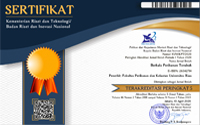IDENTIFICATION OF LACTIC ACID BACTERIA FROM BIOFLOK TECHNOLOGY WHICH HAS BEEN GAVE MOLLASES ON RED TILAPIA (Oreochromis sp.) AQUACULTURE
Abstract
Keywords
Full Text:
PDFReferences
Azim, M.E., Little,D. North, B. (2007). Growth and Welfare of Nile Tilapia (Oreochromis sp) Cultured Indoor Tank using BioFloc Tehnology (BFT). Presentation in Aquaculture 2007, 26 February - 3 March 2007. Sna Antonio, Texas, USA
Azim, M.E. Little, D.C. (2008). The biofloc technology (BFT) in indoor tanks: water quality, biofloc composition, and growth and welfare of Nile tilapia (Oreochromis niloticus). Aquaculture. 283, 29-35
Cappuccino, J.G. Sherman, N., (2001), “Microbiology: A Laboratory Manual”. New York: Addison-Wesley Publishing Company
Cowan, S. J. (1974). Cowan and Steel’s Manual for Identification of Medical Bacteria. 2nd Ed. Cambridge: Cambridge University Press
De Schryver, P., Crab, R., Defoirdt, T., Boon, N., Verstraete, W. (2008). The basics of bio-flocss technology: The added value for aquaculture. Aquaculture, 277, 125-137
Dewi, I. M. (2008). Isolasi Bakteri dan Uji Aktifitas Kitinase Termofilik Kasar dari Sumber Air Panas Tinggi Raja, Simalungun, Sumatera Utara. Tersedia dari Tesis. Sekolah Pascasarjana Universitas Sumatera Utara, Medan
Flores, M. L. (2011). The Use of Probiotic In Aquaculture: an overview. International Research Journal of Microbiology, 2, 471-478
Hatmanti, A. (2000). Penganalan Bacillus spp. Oseana, Vol. XXV, No.1, 200, 31-41
Iribarren, D., P. Dagá. M. T. Moreira., G. Feijoo. (2012). Potential environmental effects of probiotics used in aquaculture. Aquacult Int, 20, 779-789
Ismayana, A., Indrasti, N.S., Suprihatin, Akhhiruddin M., Aris.F., (2012). Faktor Rasio C/N Awal dan Laju Aerasi ada Proses CO-Composting Bagasse dan Blotong. Jurnal Teknologi Industri Pertanian, 22 (3), 173-179
Jay, J.M., M.J. Loessner. D.A. Golden. (2005). Modren Food Microbiology Seventh Edition. New York. Springer socience and Business Media. Inc
Lisdayati, Eka. (2013). Potensi Antibakteri Dari Bakteri Asosiasi Lamun (Seagrass) Dari Pulau Bonebatang Perairan Kota Makassar. Tersedia dari Fakultas Ilmu Kelautan Dan Perikanan Universitas Hasanuddin Makassar
Mulyana, D.Y. (2011). Kaya Raya dari Budidaya Ikan dengan Probiotik. Yogyakarta. Berlian media
Putra I, Rusliadi R, Fauzi. (2017). Growth Performance and Feed Unitilization of African Cat Fish Clarias gariepinus Feed Comercial Diet Reared the Biofloc System Enchanced with Probiotic
Putra, S.J. W., Nitisupardjo. M., and Widyorini. N,. (2014). Analisis Hubungan Bahan Organik Dengan Total Bakteri Pada Tambak Udang Intensif Sistem Semibioflok di BBPBAP Jepara. Diponegoro Journal of Maquares, 3, 121-129
Sarbaini. (2015). Isolasi Bakteri Kandidat Probiotik dari Usus Ikan Nila (Oreochromis niloticus) untuk Pengendalian Streptococcus agalactiae. Tersedia dari Pekanbaru: Universitas Riau
Sopian, A., Ikhsan K., Fajar Anggraeni. (2013). Pemanfaatan Bioflok dari Media Pendederan untuk Pemeliharaan Larva Udang Galah (Macrobrachuim rosenbergii). Widyariset, 16 (2), 277-232
Syulasmi, A., Hamdiyati, Y. Kusnadi. (2005). Petunjuk Praktikum Mikrobiologi
Wijaya, C. D. (2014). Identifikasi Dan Uji Aktivitas Antimikroba Bakteri Asam Laktat Yang Diisolasi Dari Rebung Kuning Bambu Betung Yang Difermentasi Pada Suhu 300 C. Tersedia dari Skripsi. Universitas Katolik Soegijapranata Semarang
Willey, J.M., Sherwood, L.M., & Woolverton, C.J., (2009), Prescott’s Principles Of Microbiology. Boston: McGraw-Hill Higher Education
DOI: http://dx.doi.org/10.31258/terubuk.47.1.83-92
Refbacks
- There are currently no refbacks.
Copyright (c) 2019 Nelli Karolina Sitorus, Iesje Lukistyowati, Henni Syawal, Iskandar Putra

This work is licensed under a Creative Commons Attribution 4.0 International License.












